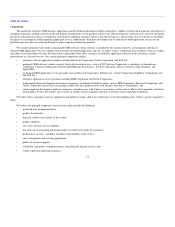Salesforce.com 2008 Annual Report Download - page 19
Download and view the complete annual report
Please find page 19 of the 2008 Salesforce.com annual report below. You can navigate through the pages in the report by either clicking on the pages listed below, or by using the keyword search tool below to find specific information within the annual report.
Table of Contents
credits or pay penalties, cause customers to terminate their subscriptions and adversely affect our renewal rates and our ability to attract new customers. Our
business will also be harmed if our customers and potential customers believe our service is unreliable.
As part of our current disaster recovery arrangements, our production environment and all of our customers' data is currently replicated in near real-time
in a separate standby facility located on the east coast. Features added through acquisition are temporarily served through alternate facilities. We do not
control the operation of any of these facilities, and they are vulnerable to damage or interruption from earthquakes, floods, fires, power loss,
telecommunications failures and similar events. They may also be subject to break-ins, sabotage, intentional acts of vandalism and similar misconduct.
Despite precautions taken at these facilities, the occurrence of a natural disaster or an act of terrorism, a decision to close the facilities without adequate notice
or other unanticipated problems at these facilities could result in lengthy interruptions in our service. Even with the disaster recovery arrangements, our
service could be interrupted.
If our security measures are breached and unauthorized access is obtained to a customer's data or our data, our service may be perceived as not
being secure, customers may curtail or stop using our service and we may incur significant legal and financial exposure and liabilities.
Our service involves the storage and transmission of customers' proprietary information, and security breaches could expose us to a risk of loss of this
information, litigation and possible liability. If our security measures are breached as a result of third-party action, employee error, malfeasance or otherwise,
during transfer of data to additional data centers or at any time, and, as a result, someone obtains unauthorized access to our data or our customers' data, our
reputation could be damaged, our business may suffer and we could incur significant liability. Additionally, third parties may attempt to fraudulently induce
employees or customers into disclosing sensitive information such as user names, passwords or other information in order to gain access to our data or our
customers' data, which could result in significant legal and financial exposure and a loss of confidence in the security of our service that would harm our
future business prospects. Because the techniques used to obtain unauthorized access, or to sabotage systems, change frequently and generally are not
recognized until launched against a target, we may be unable to anticipate these techniques or to implement adequate preventative measures. If an actual or
perceived breach of our security occurs, the market perception of the effectiveness of our security measures could be harmed and we could lose sales and
customers. In addition, our customers may authorize third party technology providers, whose applications are available through our AppExchange directory,
to access their customer data. Because we do not control the transmissions between our customers and third-party AppExchange technology providers, or the
processing of such data by third-party AppExchange technology providers, we cannot ensure the complete integrity or security of such transmissions or
processing.
Weakening global economic conditions may adversely affect our industry, business and results of operations.
Our overall performance depends in part on worldwide economic conditions. The United States and other key international economies are currently
undergoing a period of severe recession, characterized by falling demand for a variety of goods and services, restricted credit, going concern threats to
financial institutions and major multi-national companies, poor liquidity, declining asset values, reduced corporate profitability, extreme volatility in credit,
equity and foreign exchange markets and increased bankruptcies. These conditions could adversely affect our customers' ability or willingness to purchase our
enterprise cloud computing application service, delay prospective customers' purchasing decisions, reduce the value or duration of their subscription contracts,
or affect renewal rates, all of which could adversely affect our operating results. Companies that have competing products may reduce prices for competing
products or services which could also reduce our average selling prices and harm our operating results.
16
























